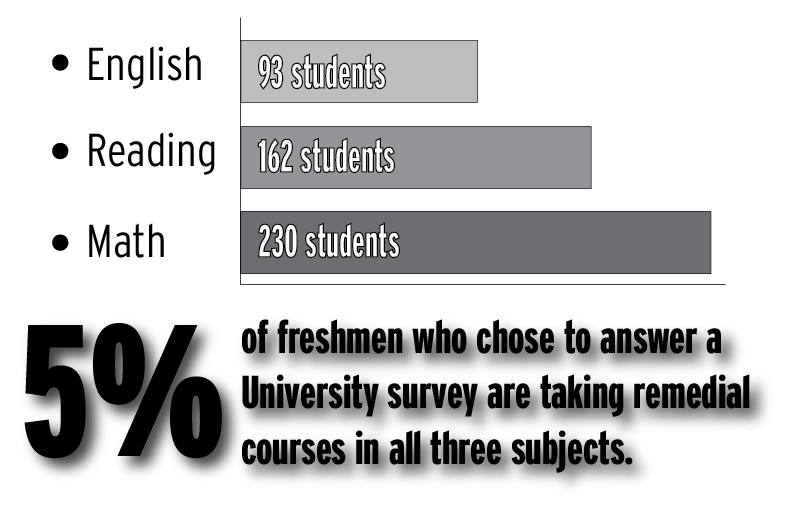Five percent of respondents to a New Student Freshmen Survey are enrolled in all three available remedial courses.
The survey was answered by 873 of approximately 1,454 Murray State freshmen.
That 5 percent is an estimate of the freshman class, since 40 percent of freshmen did not complete the survey.
Students may be placed in either math, English or reading remedial courses depending on their American College Testing (ACT) scores.
For math ACT scores, the score requiring remediation is 18 or below.
For English ACT scores, the score requiring remediation is 17 or below.
For reading ACT scores, the score requiring remediation is 19 or below.
In a June 2009 report from the Kentucky Council on Postsecondary Education, 5,972 of the 18,114, which is 33 percent, first-time freshmen at four-year public Kentucky universities were enrolled in remedial courses.

For Murray State, 418 of 1,399 first-time freshman, or 29.9 percent, were enrolled in remedial courses in 2009.
When Katie Byrnes, junior from Memphis, Tenn., came to Murray State as a freshman, she said she had to take MAT 096 due to her ACT score.
Byrnes said she thought it was easy since she took the course in high school, but did not see it as helpful when taking higher-level math courses.
“It was helpful for when I took the PPST (Pre-Professional Skills Test), which is the test to get into teacher education services,” she said. “But it did not really help me with the next math course I took, which was MAT 117.”
Students like Byrnes take remedial courses in the Lowry Center, where Director for Continuing Education and Academic Outreach Shauna Mullins oversees resources such tutoring services.
Mullins said tutoring at Lowry is available to all Murray State students regardless of whether or not they are taking remedial courses.
Tutoring for remedial classes include all mathematics courses below 250, and English classes 095 and 100.
Tutoring is also available for upper-level, program-specific courses.
With tutoring, Mullins said students, remedial and not, tend to need more help with mathematics and sciences.
“The math and sciences are the strongest,” Mullins said of student tutoring attendance. “That’s what we have the most of available. We typically do see a pretty good turnout. Last year we had more than 250 students come see us.”
Mullins said some students come for a few hours a week, but she said others will spend nearly 20 to 30 hours a week in tutoring.
For students who are taking remedial classes, there are many resources such as summer courses and tutoring available to help them adjust to college-level courses.
However, the number of students accepted into Murray State needing remedial courses may change.
Fred Dietz, associate vice president of Enrollment Management, said the Admissions Office will begin to look at its admission criteria and possibly make it more rigorous for the upcoming year.
“It’s one of our goals to look at the admission criteria, but also the students that are successful at Murray State, what their ACT and GPA is out of high school and if they’re graduating in four, five or six years,” Dietz said. “It’s on the president’s agenda and we’ll begin to put a group together to look at it.”
Dietz said there are students who can enroll in summer courses to help prepare them for the fall.
By taking these courses, he said the students’ success rate during the summer can help determine how they will do during the school year.
However, if no improvements are shown, they cannot continue to take classes in the fall.
Dietz added that transitioning from the summer remedial courses to the fall semester can be difficult for students with full residential colleges and many more students returning to campus, but the students still have to meet academic requirements.
“They have to adhere to good academic standing to be able to stay, so that’s their benchmark,” Dietz said. “They have to be performing well to continue on.”
Additionally, students and University members will work with the retention office to help the students stay on campus through counseling and speaking to students who at at-risk of leaving.
“With retention and enrollment, it’s a collective effort,” Dietz said. “It’s not one person, it’s faculty, staff and students, too.”
Story by Mary Bradley, Assistant News Editor